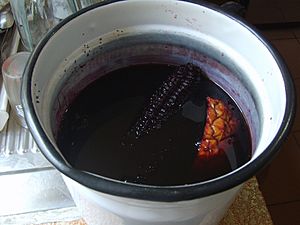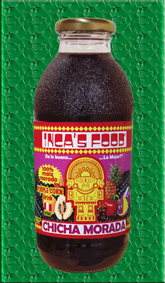Chicha morada facts for kids

Two traditional Peruvian drinks paired together, chicha morada (right) and pisco sour (left).
|
|
| Type | Beverage |
|---|---|
| Country of origin | |
| Color | Purple |
| Style | Glass |
| Ingredients | Purple corn |
Chicha morada is a popular purple drink that comes from the Andes Mountains in Peru. Even though it started there, people all over Peru drink it today!
The main ingredient for Chicha morada is a special kind of corn called culli or ckolli. This corn is better known as purple corn and grows a lot in the Andes Mountains.
People were drinking Chicha morada even before the famous Inca Empire existed. So, it has a very long history! We know how it was made in the past from writings by people like Camille Pradier-Fodéré in the 1870s.
Contents
How to Make Chicha Morada
You can enjoy Chicha morada in a few different ways today: homemade, from a mix, or ready-to-drink from a bottle.
Traditional Homemade Chicha
To make Chicha morada the old-fashioned way, you boil purple corn in water. You also add pineapple peels and pieces of quince. For extra flavor, a little cinnamon and a few cloves are added. After boiling, the mixture is strained and cooled down. Then, you can add sugar (or a type of brown sugar called chancaca), chopped fruit, and lemon juice if you like. It's a fresh and tasty drink!
Chicha from a Mix
Sometimes, Chicha morada is sold as a mix. This can be:
- Powder packets: These are dry powders that you just add water to. They are cheap and sweet, but they don't taste exactly like homemade chicha. They also don't have all the healthy stuff (like antioxidants) that comes from real purple corn.
- Concentrated syrup: These are bags of purple chicha syrup. They have a lot of the fruit flavor and smell. You just add water and lemon juice to make a big batch.
Ready-to-Drink Chicha
You can also buy Chicha morada already made and bottled. These are like soft drinks and come in small cans or bottles. They are super convenient if you want a quick drink!
Mazamorra Morada
Did you know you can also make a yummy dessert from Chicha morada? It's called "mazamorra morada." To make it, you add something to thicken the traditional Chicha morada, like chuño or corn starch. This makes it into a porridge-like treat. People often add dried or fresh fruits like prunes and raisins. Mazamorra morada is very popular in Peru, especially during October, which is a special month for celebrations.
Chicha's Big Impact
Chicha morada is a really important drink in Peruvian culture.
- It's so popular that sometimes more Chicha morada is sold in Peru than even Coca-Cola! You can find it in almost every restaurant and supermarket.
- Peruvian companies even send bottled Chicha morada to places like North America, Europe, Australia, and Japan. This is especially true in countries where many Peruvian people live.
- In 2007, a company called Alicorp started selling ready-to-drink bottled Chicha morada under their Negrita brand.
- Chicha morada is seen as a special drink that represents Peruvian cuisine. It's refreshing and goes well with many different foods. People of all ages, from young to old, enjoy it.
- In October, which Peruvians call the 'purple month' (because of a big religious procession in Lima), Chicha morada is often enjoyed with other famous Peruvian foods like anticuchos, picarones, and turrón de Doña Pepa.
See also
 In Spanish: Chicha morada para niños
In Spanish: Chicha morada para niños



